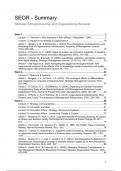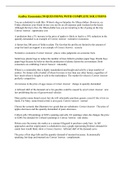SEOR - Summary
Strategic Entrepreneurship and Organizational Renewal
Week 1..................................................................................................................................... 3
Lecture 1.1 Overview + Why important + Why difficult + Separation - UAS.......................3
Lecture 1.2 Impact AI on Strategy & Organizations......................................................... 10
Article 1 - Gibson, C. B., & Birkinshaw, J. (2004). The Antecedents, Consequences, and
Mediating Role of Organizational Ambidexterity. Academy of Management Journal,
47(2), 209–226................................................................................................................. 15
Article 2 - O’Connor, G. C. (2008). Major Innovation as a Dynamic Capability: A Systems
Approach. Journal of Product Innovation Management, 25(4), 313–330.........................19
Article 3 - Tripsas, M., & Gavetti, G. (2000). Capabilities, cognition, and inertia: evidence
from digital imaging. Strategic Management Journal, 21(10–11), 1147–1161..................25
Article 4 - Dell´Aqua et al., 2023. Navigating the jagged technological frontier: field
experimental evidence of the effects of AI on knowledge worker productivity and quality.
Working paper, Harvard Business School 24 – 013.........................................................29
Week 2................................................................................................................................... 32
Lecture 2.1 Structure & Systems......................................................................................32
Article 1 - Burgers, J. H., & Covin, J. G. (2016). The contingent effects of differentiation
and integration on corporate entrepreneurship. Strategic Management Journal, 37(3),
521–540........................................................................................................................... 37
Article 2 - O’Connor, G. C., & DeMartino, R. (2006). Organizing for Radical Innovation:
An Exploratory Study of the Structural Aspects of RI Management Systems in Large
Established Firms. Journal of Product Innovation Management, 23(6), 475–497............45
Article 3 - O’Reilly, C. A., & Tushman, M. L. (2013). Organizational Ambidexterity: Past,
Present, and Future. The Academy of Management Perspectives, 27(4), 324–338....... 52
Week 3................................................................................................................................... 56
Lecture 3.1 Strategy and Leadership............................................................................... 56
Lecture 3.2 Innovation and Bias.......................................................................................61
Lecture 3.3 Innovation Killers - Strategy, Structure & Systems........................................69
Lecture 3.4 Innovation Killers - Leadership, People & Culture.........................................72
Article 1 - Meissner, P., Wulf, T., 2013. Cognitive benefits of scenario planning: Its impact
on biases and decision quality. Technological Forecasting & Social Change, 80, 801 –
814................................................................................................................................... 74
Article 2 - Hammond, J.S., Keeney, R.L., Raiffa, H., 1998. The Hidden Traps in Decision
Making. Harvard Business Review, Sep – Oct.................................................................78
Article 3 - Tversky, A., Kahneman, D. Judgment under Uncertainty: Heuristics and Biases
in judgments reveal some heuristics of thinking under uncertainty. Science, 185, 1123 -
1131..................................................................................................................................83
Article 4 - Maula, M. V. J., Keil, T., & Zahra, S. A. (2012). Top Management’s Attention to
Discontinuous Technological Change: Corporate Venture Capital as an Alert Mechanism.
Organization Science, 24(3), 926 - 947............................................................................88
Article 5 - Smith, W. K., & Tushman, M. L. (2005). Managing Strategic Contradictions: A
Top Management Model for Managing Innovation Streams. Organization Science, 16(5),
522–536........................................................................................................................... 96
1
, Article 6 - Raffaeilli, R. L., Glynn, M. A., & Tushman, M. 2018. Flexing the frame: TMT
framing and the adoption of non-incremental innovations by incumbent firms. Harvard
Business School Organizational Behavior Unit Working Paper, 17-091........................ 104
Article 7 - Richard, O., Wu, J., Markoczy, L., Chung, Y., 2019. Top management team
demographic-faultline strength and strategic change: What role does environmental
dynamism play? Strategic Management Journal, 40, 6, 987 – 1009..............................111
Week 4................................................................................................................................. 117
Lecture 4.1 Culture & People......................................................................................... 117
Exercise Culture Innovation teams.................................................................................121
Article 1 - Schilling, M. A. 2017. Serial Breakthrough Innovation: The Roles of
Separateness, Self-Efficacy, and Idealism. Working Paper............................................123
Article 2 - Tellis, G. J., Prabhu, J. C., & Chandy, R. K. (2009). Radical Innovation Across
Nations: The Preeminence of Corporate Culture. Journal of Marketing, 73(1), 3–23.... 128
Article 3 - O’Connor, G. C., Corbett, A., & Pierantozzi, R. (2009). Create Three Distinct
Career Paths for Innovators. Harvard Business Review................................................ 135
Article 4 - Tripsas, M. (2009). Technology, Identity, and Inertia Through the Lens of “The
Digital Photography Company.” Organization Science, 20(2), 441–460........................ 137
Article 5 - Kammerlander, N., König, A., & Richards, M. (2018). Why do incumbents
respond heterogeneously to disruptive innovations? The interplay of domain identity and
role identity. Journal of Management Studies. 55, 1122 - 1165......................................142
Article 6 - Perra, D., Sidhu, J., Volberda, H., 2017. How do established firms produce
breakthrough innovations? Managerial identity-dissemination discourse and the creation
of novel product-market solutions. Journal of Product Innovation Management, 34, 4, 509
– 525.............................................................................................................................. 150
Week 5................................................................................................................................. 154
Lecture 5.1 Volvo Digital Innovation & Integration..........................................................154
Article 1 - Keil, T., McGrath, R. G., & Tukiainen, T. (2009). Gems from the Ashes:
Capability Creation and Transformation in Internal Corporate Venturing. Organization
Science, 20(3), 601–620................................................................................................ 158
Article 2 - Khanna, R., Guler, I., & Nerkar, A. (2016). Fail Often, Fail Big, and Fail Fast?
Learning from Small Failures and R&D Performance in the Pharmaceutical Industry.
Academy of Management Journal, 59(2), 436–459....................................................... 164
Article 3 - Lange, D., Boivie, S., & Henderson, A. D. (2009). The Parenting Paradox: How
Multibusiness Diversifiers Endorse Disruptive Technologies While Their Corporate
Children Struggle. Academy of Management Journal, 52(1), 179–198......................... 170
Article 4 - Raisch, S., & Tushman, M. L. (2016). Growing New Corporate Businesses:
From Initiation to Graduation. Organization Science, 27(5), 1237–1257....................... 177
Week 6................................................................................................................................. 185
Lecture 6.1 From Underperformer to Worldclass - Digital Transformation.....................185
Article 1 - Collis & Tunker (2018) Digitalization at Siemens........................................... 188
Article 2 - Teece, D., 1997. Explicating dynamic capabilities: the nature and
micro-foundations of (sustainable) enterprise performance. Strategic Management
Journal, 28, 1319 - 1350................................................................................................ 192
Article 3 - Birkinshaw, J., Zimmerman, A., Raisch, S. 2016. How do firms adapt to
discontinuous change? Bridging the dynamic capabilities and ambidexterity perspectives.
California Management Review, 58, 36 – 58..................................................................203
2
,Week 1
Lecture 1.1 Overview + Why important + Why difficult +
Separation - UAS
Firm survival rates
● Less than 0.1% of US firms live to the age of 40
● For example, firms founded in 1976
○ 10% survived 10 years later
○ 2,5% survived 20 laters
Firms’ life expectancy going down
Google is the largest threat to Google.
Money does not create successful innovations.
Firm survival rates
So, it is not about:
● Being big (size).
● Being strong (money).
● Being smart (IQ).
“It is not the strongest of the species that survive, nor the most intelligent, but the one most
responsive to change”.
The lower box is the innovation box
This box is basically the activities that
organizations (larger or small, young or old)
do to innovate. At a certain point they think
now we have hit the jackpot now we scale
up and commercialize these projects.
- Being creative, starting to experiment,
doing R&D etc.
The organizational conditions effects
(positive of negative) the execution process
For many companies these conditions form
a hostile environment for innovation.
3
,Different kinds of innovations
Product life cycle / s-curve
4
,Fluid Phase
Example
Fluid phase - organizational implications
● Strong emphasis on:
○ Frequent redefinition of tasks.
○ Limited hierarchy.
○ High lateral communication.
● Organic structure → adaptability (high environmental uncertainty).
Specific phase - organizational implications
● Strong emphasis on:
○ Stable tasks.
○ More hierarchy: coordination and control.
○ Top-down communication.
5
, ● Mechanistic structure → predictability (low environmental uncertainty). What does a
mechanistic structure offer? Control over your processes, cost reduction and
predictability (you are reliable in the eyes of the consumer).
From fluid to specific phase - key organizational changes
● Structure: from Informal to Formal.
● Organizational behavior: from Flexible and Responsive to Rigid and Predictable.
● Power: from Entrepreneurs to Managers.
● Orientation: from External to Internal.
Why is it so difficult for companies to adapt?
See the picture of the horses on the slide. You cannot say if the where the with horses turn
black it is a smooth process. The same happens at organizations.
Innovation discontinuities
6
,Innovation discontinuities
● Competence enhancing:
○ Large improvements in price/performance.
○ Builds on existing knowledge.
○ New products or new processes.
“Rich get richer”: established players benefit.
● Competence destroying:
○ Large improvements in price/performance.
○ Existing knowledge becomes obsolete.
○ Entirely different knowledge and competencies.
“Rich get poor(er)”: new entrants benefit.
Digital disruption
Improvement vs. renewal
How can firms respond?
7
,Which one is more important (Incremental or radical)?
Both. You need left to survive on the short term, yet if you only do left there is no
guarantee you survive in the long term. Right costs you money on short term but it is
ESSENTIAL for continuity in the long term.
You do left and right – your firm has a ticket to eternal life. In the end that is the goal
we are after. The rest of the course -> How can we do it? Why is it so difficult? When
it is so difficult, how can we realize it?
Example: Amazon started as a bookstore
on the web. Amazon started to invest in
cloud computing. That was a really radical
innovation, it was a costly process. But
with this cloud computing Amazon started
a web service. Amazon created a
disruptive innovation that created direct
competition for Amazon itself. The
webstore became a secondary business.
So renewal overtakes improvement.
They're investing in something and it
disrupts websites and apps and therefore
disrupts itself. Conclusion: If you want to
have internal life as an organization you do improvement and
renewal and you will live forever.
Why are there little successes in innovation and many failures? Why is it so difficult?
“Knowledge makes you wise in some ways, but can make you a blindfolded fool in others”.
Not invented here syndrome -> if we haven’t invented it it is not worth paying attention to it.
8
,9
, Lecture 1.2 Impact AI on Strategy & Organizations
Global economic impact - first estimates
$ 4.4 – 7 trillion added annually to global GDP.
- from about 2027 - 2037.
“Singularity”: half of all work automated.
- between 2040 – 2060.
- decade earlier than earlier estimates.
- singularity = AI more intelligent than humans.
AI or LLM: key features
1. Surprising abilities.
● high performance in professional contexts.
● medicine, law, business, education, …
● strongest for creative, well-paid and highly educated workforce.
2. Easy of use.
● no organizational or technological investment upfront.
● close to zero marginal cost for individual use.
3. Relative opacity and unclear failures.
● high performance in some cases, hallucinations in others.
● difficult to predict ex-ante.
● trial & error and ongoing sharing of experiences
(e.g. user groups, hackathons, X, YouTube).
Generic performance effects
1. Experiment at BCG (April, 2023):
- 758 consultants (7% of total).
- use of AI vs. control group.
10






